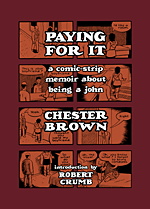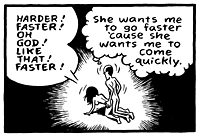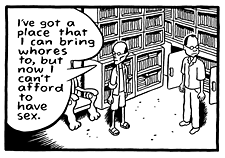 By Chester Brown
By Chester Brown
288 pages, black and white
Published by Drawn & Quarterly
It’s been eight years since Chester Brown’s last graphic novel (a collection of his biographical mini-series of Canadian political leader Louis Riel), and his work has always been wide ranging, but had you told me that his new book would be about Brown’s experiences with prostitutes I wouldn’t have believed you. On the surface it sounds like a crass, flippant subject. What Paying For It actually delivers, though, is a thoughtful and interesting examination on the life of a john and on prostitution in general.
 One of the things I appreciated right off the bat was that we don’t ever get a definitive "this is right, this is wrong" statement in Paying For It‘s main narrative. As Brown explains to his friends what he’s going through and his feelings on the matter, we get responses from Joe Matt and Seth on their own feelings on the matter. And while this is clearly Brown’s book, he doesn’t suppress or hide these other viewpoints on prostitution. With that in mind, Paying For It follows Brown’s life as his girlfriend Sook-Yin breaks up with him in 1996, but the two decide to still live together. Deciding that he’s never going to have a girlfriend again, he figures this will mean he’ll have to go without sex.
One of the things I appreciated right off the bat was that we don’t ever get a definitive "this is right, this is wrong" statement in Paying For It‘s main narrative. As Brown explains to his friends what he’s going through and his feelings on the matter, we get responses from Joe Matt and Seth on their own feelings on the matter. And while this is clearly Brown’s book, he doesn’t suppress or hide these other viewpoints on prostitution. With that in mind, Paying For It follows Brown’s life as his girlfriend Sook-Yin breaks up with him in 1996, but the two decide to still live together. Deciding that he’s never going to have a girlfriend again, he figures this will mean he’ll have to go without sex.
Flash forward to 1999, and we’re watching Brown become a john for the first time, as he nervously meets a prostitute for some outcall work. There’s some humor in those early encounters; Brown looking under the bed, in the closet, and in the bathroom to make sure that no one is hiding there, or trying to figure out if he should take his shoes off or not (in case he has to run). In many ways it serves to not only poke fun at Brown, but also to help let down the guard of the reader. What might otherwise scare a reader off is instead an entertaining sequence that segues into the actual sex part of the story.
 What we get from this point is where the meat of the story shows up. It’s a combination of a series of conversations between Brown and Matt, Seth, and Sook-Yin about the nature of prostitution, as well as Brown’s many, many encounters with prostitutes over the next few years and how his initial nervousness turns into a rather blasé, almost jaded look at the entire experience. It’s not that he starts to look down on hiring prostitutes (not at all, in fact) but rather he starts to recognize certain patterns with some women, and some of the tricks of the trade, so to speak. Brown doesn’t come across as someone particularly wise when these moments hit, though. Instead it’s in such a dispassionate voice that it’s actually a little sad. Comparing this Brown to the one who feels like a weight has been lifted off of his shoulders after that initial encounter is rather startling. Brown has slowly lost a lot of the optimism that he first experienced with his new outlook on sex.
What we get from this point is where the meat of the story shows up. It’s a combination of a series of conversations between Brown and Matt, Seth, and Sook-Yin about the nature of prostitution, as well as Brown’s many, many encounters with prostitutes over the next few years and how his initial nervousness turns into a rather blasé, almost jaded look at the entire experience. It’s not that he starts to look down on hiring prostitutes (not at all, in fact) but rather he starts to recognize certain patterns with some women, and some of the tricks of the trade, so to speak. Brown doesn’t come across as someone particularly wise when these moments hit, though. Instead it’s in such a dispassionate voice that it’s actually a little sad. Comparing this Brown to the one who feels like a weight has been lifted off of his shoulders after that initial encounter is rather startling. Brown has slowly lost a lot of the optimism that he first experienced with his new outlook on sex.
It’s the last third of the book that ends up being, for lack of a better word, the most conversation-inducing. Brown makes a big decision in how he’s going to treat his favorite prostitute, and in doing so, the book comes to a sudden and abrupt conclusion. After over 100 pages of watching Brown go to prostitute after prostitute (some of them repeats, others new), the entire book wraps up in eight pages. It’s a startling and somewhat unsatisfying conclusion to the narrative, and people who haven’t flipped through the book before reading will be especially surprised since there are a good 60 pages left in the physical book itself. It’s there that Brown writes a series of appendices (with spot illustrations), where he explains in far greater detail his feelings on prostitution, why it should be normalized, and in doing so answers a lot of questions that he’s been asked about the trade. And while I appreciated that in the main narrative there are no "this is the answer" definitive statements being handed out, it’s here that Brown gets a little preachy. I understand why it’s here; these are points that he’s no doubt tired of having to bring up with people who know him, and by going public with Paying For It they’re a series of questions that will be asked in greater frequency. But none the less, this is a much starker, more black-and-white laying out of Brown’s beliefs here. With no one to argue them, it comes across as a well-mannered screed of sorts, and I’ll admit that toward the end I found myself skimming rather than reading the pages. I’m not someone who enjoys being lectured at (regardless of if I agree, disagree, or fall somewhere in the middle with the lecture) and I suspect I’m not the only one.
 While I enjoy Brown’s comics, there’s no denying that his art style is extremely simple and straight-forward. In the past he’s drawn his comics as a series of individual, same-size rectangles that he could then paste onto pieces of paper and re-arrange as necessary, and I saw nothing here to make me think that he’s not still doing so. There’s no variation on page layouts—panels are two-to-a-row, unless there are an odd number of panels in a chapter in which case the last panel is by itself, centered— and Brown’s people look remarkably similar to one another. Aside from different levels of male-pattern baldness (and a hat), there’s no way to tell Brown, Matt, and Seth apart from one another, for example. Sequences with Brown and Seth walking and talking are near-identical, the two in the same position in every panel, with only a silhouette of a building changing, plus the occasional puff of cigarette smoke from Seth. Brown makes his comics work because of his sense of pacing and overall interesting stories, but his sequential art in general comes across much more as a series of storyboards for a film than as a graphical creation to be relished and studied on the basis of his art skills.
While I enjoy Brown’s comics, there’s no denying that his art style is extremely simple and straight-forward. In the past he’s drawn his comics as a series of individual, same-size rectangles that he could then paste onto pieces of paper and re-arrange as necessary, and I saw nothing here to make me think that he’s not still doing so. There’s no variation on page layouts—panels are two-to-a-row, unless there are an odd number of panels in a chapter in which case the last panel is by itself, centered— and Brown’s people look remarkably similar to one another. Aside from different levels of male-pattern baldness (and a hat), there’s no way to tell Brown, Matt, and Seth apart from one another, for example. Sequences with Brown and Seth walking and talking are near-identical, the two in the same position in every panel, with only a silhouette of a building changing, plus the occasional puff of cigarette smoke from Seth. Brown makes his comics work because of his sense of pacing and overall interesting stories, but his sequential art in general comes across much more as a series of storyboards for a film than as a graphical creation to be relished and studied on the basis of his art skills.
Overall I think Paying For It is definitely a good book, but its flaws—the extremely rushed and sudden ending (after an extended sequence hitting the same notes), the preachy appendices, the slightly dull art—keep it from being a great book. Is it worth reading? Absolutely. I appreciate that it challenges people’s notions of prostitution, and provides a fascinating look into one person’s extended experiences with the practice. But go into it with the understanding that it’s not a perfect book, and you’ll end up with a stronger final impression of Paying For It.
Purchase Links: Amazon.com | Powell’s Books
